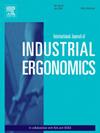Affective judgment of viewing an illuminated in-product space in relation to the surrounding lighting
IF 2.5
2区 工程技术
Q2 ENGINEERING, INDUSTRIAL
International Journal of Industrial Ergonomics
Pub Date : 2025-04-09
DOI:10.1016/j.ergon.2025.103742
引用次数: 0
Abstract
This study deals with the appropriate lighting conditions within in-product spaces, focusing on two parameters: illuminance and correlated color temperature (CCT), in relation to the surrounding light conditions. The study was structured around two main experiments. The first experiment investigated how the perceived illuminance inside these in-product spaces correlates with the intensity of surrounding light, demonstrating that preferred interior lighting levels are directly influenced by surrounding lighting conditions and the color of the interior surfaces. The optimal illuminance was predicted using a regression model: Best Illuminance = 18.20 × L value of product +.70 × Surrounding illuminance - 514.30 (R2 = .75), indicating that preferred in-product illuminance increases with higher surrounding illuminance. The second experiment examined the perception of ’whiteness’ and preference for in-product space lighting CCT under varying CCT of surrounding light. The results showed that higher surrounding CCT significantly increased the perceived white point of in-product. The perceived white point was predicted using a model: 106∕Correlated Color Temperature of Whitest Light = 3.13 × 105 × Surrounding Correlated Color Temperature +150.69 (R2 = .57), indicating that the perceived white point shifts toward higher CCT under cooler surroundings. Additionally, participants preferred a higher CCT than the perceptual white point as the lighting within the in-product space. These experiments provide concrete guidelines for designing lighting within in-product spaces, offering predictive models for both illuminance and CCT to support more effective and user-preferred lighting solutions across various product settings.

观察产品内部照明空间与周围照明的关系的情感判断
本研究涉及产品空间内适当的照明条件,重点关注两个参数:照度和相关色温(CCT),与周围光线条件有关。这项研究围绕两个主要实验展开。第一个实验调查了这些产品空间内的感知照度如何与周围光的强度相关,表明首选的内部照明水平直接受到周围照明条件和内部表面颜色的影响。采用回归模型预测最佳照度:最佳照度= 18.20 × L产品+值。70 ×周围照度- 514.30 (R2 = .75),表明产品内首选照度随周围照度的增加而增加。第二个实验考察了在不同环境光的CCT下,产品空间照明的“白度”感知和偏好。结果表明,较高的周围CCT显著增加了产品中的感知白点。采用106∕最白光相关色温= 3.13 × 105 ×周围相关色温+150.69 (R2 = 0.57)模型预测感知白点,表明在较冷的环境下,感知白点向较高的CCT偏移。此外,参与者更倾向于使用比感知白点更高的CCT作为产品空间内的照明。这些实验为设计产品空间内的照明提供了具体的指导方针,为照度和CCT提供了预测模型,以支持在各种产品设置中更有效和用户首选的照明解决方案。
本文章由计算机程序翻译,如有差异,请以英文原文为准。
求助全文
约1分钟内获得全文
求助全文
来源期刊
CiteScore
6.40
自引率
12.90%
发文量
110
审稿时长
56 days
期刊介绍:
The journal publishes original contributions that add to our understanding of the role of humans in today systems and the interactions thereof with various system components. The journal typically covers the following areas: industrial and occupational ergonomics, design of systems, tools and equipment, human performance measurement and modeling, human productivity, humans in technologically complex systems, and safety. The focus of the articles includes basic theoretical advances, applications, case studies, new methodologies and procedures; and empirical studies.

 求助内容:
求助内容: 应助结果提醒方式:
应助结果提醒方式:


